Samurai Culture Experience at the Samurai Kembu Theater in Kyoto
Every year TripAdvisor, the world’s largest traveler review website, announces a ranking of the most popular Japanese tourist spots among foreign visitors, and in 2015 the Samurai Kembu Theater in Higashiyama-ku, Kyoto, came eighth, ahead of many other famous tourist destinations around the country. I visited the theater to find out why it is so popular, observing its program of lessons and shows and asking participating foreign tourists for their impressions.
Introducing Samurai Culture to the World
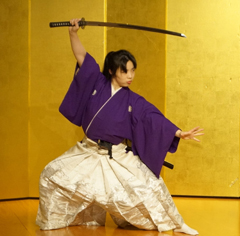 The Samurai Kembu Theater (kembu means sword dance) occupies the basement of a building near the intersection between Sanjo-dori and Hanamikoji-dori streets. It is run by Ms. Auga Magari, a master of the Seiga school of sword dancing in Shiga Prefecture. I asked Ms. Magari, who is the granddaughter of the head of the Seiga school, what sword dancing is and why she established the theater in Kyoto.
The Samurai Kembu Theater (kembu means sword dance) occupies the basement of a building near the intersection between Sanjo-dori and Hanamikoji-dori streets. It is run by Ms. Auga Magari, a master of the Seiga school of sword dancing in Shiga Prefecture. I asked Ms. Magari, who is the granddaughter of the head of the Seiga school, what sword dancing is and why she established the theater in Kyoto.
“The sword dance is one of Japan’s traditional performing arts,” she explained. “Performers are dressed in samurai costumes and equipped with a sword and folding fan, and they dance to the accompaniment of a Chinese or Japanese poem recital and music. 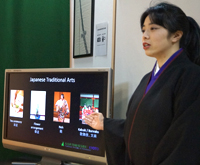 Each dance lasts about two and a half minutes and is a condensation of the values and spirituality of the samurai. Samurai culture is one of the roots of Japanese culture, and in many ways its values and aesthetic sense remain alive among the Japanese today. Many foreign tourists come to Kyoto in search of a Japanese experience, so I wanted to contribute to the promotion of multicultural understanding by telling them in English about samurai culture and the ‘Japaneseness’ that is rooted in this culture and letting them experience it. At the same time, it is my hope that if foreigners can appreciate and enjoy sword dancing, then understanding of this traditional performing art will deepen here in Japan as well.”
Each dance lasts about two and a half minutes and is a condensation of the values and spirituality of the samurai. Samurai culture is one of the roots of Japanese culture, and in many ways its values and aesthetic sense remain alive among the Japanese today. Many foreign tourists come to Kyoto in search of a Japanese experience, so I wanted to contribute to the promotion of multicultural understanding by telling them in English about samurai culture and the ‘Japaneseness’ that is rooted in this culture and letting them experience it. At the same time, it is my hope that if foreigners can appreciate and enjoy sword dancing, then understanding of this traditional performing art will deepen here in Japan as well.”
60-Minute Samurai Experience
The Samurai Kembu Theater offers two types of lesson: a 60-minute “light” lesson and a 105-minute “full” lesson. On the day of my visit, I watched the light lesson from 11:15 and the following full lesson. There were two pairs taking part in the light lesson: Mr. Heikki Huhta and Ms. Essi Huhta, a married couple from Finland, and Mr. Tom Soffer and Mr. Leo Soffer, two brothers from France. Participating in the full lesson were four members of the Marriott family from the United States (David, Andrew, Jack, and Henry). They all kindly agreed to let me watch and report on their samurai experience.
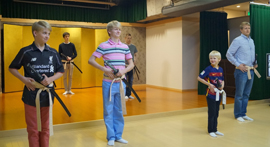 The light lesson began with the participants, wearing an obi around their waist, learning how to handle a model sword. Standing on the wooden training floor in tabi-like split-toe socks, they followed the teacher’s instructions and practiced holding their swords, inserting them in their obi, and drawing them. When they wore the swords hanging from their waists, the participants looked very chuffed indeed. (The three Marriott boys in particular were all smiles!)
The light lesson began with the participants, wearing an obi around their waist, learning how to handle a model sword. Standing on the wooden training floor in tabi-like split-toe socks, they followed the teacher’s instructions and practiced holding their swords, inserting them in their obi, and drawing them. When they wore the swords hanging from their waists, the participants looked very chuffed indeed. (The three Marriott boys in particular were all smiles!)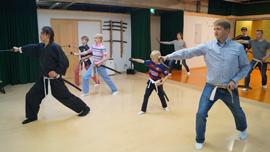
They then practiced holding their swords and swinging them down. The downswing seemed to be especially hard for them. Facing the mirror covering one wall, and with serious expressions on their faces, they repeated the action over and over again in accordance with the instructions and encouragement of the teacher. As the teacher gave suggestions about posture and waist movement and urged the participants to relax, gradually their swords began to emit good sounds as they cut through the air. Smiling once more, they went on to practice other techniques, such as drawing the sword sideways and turning to cut down an enemy behind you.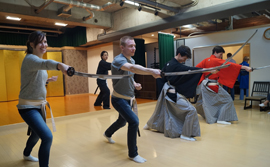 After practicing these motions, the Soffer brothers from France changed into kimono for a photo. Replying cheerfully to my questions, they told me that they were visiting Japan for a week of sightseeing together with their parents and were looking forward to seeing cherry blossoms and manga. They applied for the sword dance lesson after reading about it on the Internet. Since they were interested in how to use swords, it had been a wonderful experience for them.
After practicing these motions, the Soffer brothers from France changed into kimono for a photo. Replying cheerfully to my questions, they told me that they were visiting Japan for a week of sightseeing together with their parents and were looking forward to seeing cherry blossoms and manga. They applied for the sword dance lesson after reading about it on the Internet. Since they were interested in how to use swords, it had been a wonderful experience for them.
The Huhta couple from Finland, the other participants in the light lesson, told me that they had wanted to visit a distant country and so had come to Japan. They had chosen the samurai sword dance because of their interest in martial arts and Japanese culture. The sword techniques and actions had been very enjoyable, they said.
As the end of the lesson approached, these two pairs practiced a final technique and then posed for commemorative photos. After the 60-minute lesson they obviously felt quite comfortable with their swords and adopted dashing samurai poses before the camera.
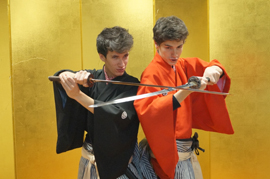
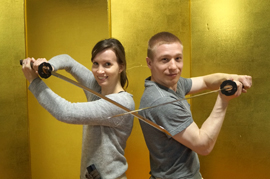
Full Sword Dance Lesson

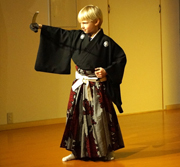 For the class that followed, the Marriott family from the United States, who had applied for the full lesson, changed into samurai costumes of their choice. The full lesson consists of practice of a sword dance to the accom-paniment of a poem recital with music and finally a performance by each participant.
For the class that followed, the Marriott family from the United States, who had applied for the full lesson, changed into samurai costumes of their choice. The full lesson consists of practice of a sword dance to the accom-paniment of a poem recital with music and finally a performance by each participant.
During a break in the lesson I spoke with the father, 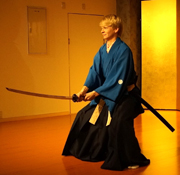
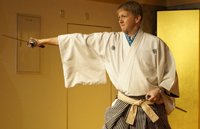 Mr. David Marriott, who told me that his wife, who was not with them on that day, had applied for the samurai sword dance after hearing about it from a hotel concierge. When I asked about his impressions before the lesson and now, he replied,
Mr. David Marriott, who told me that his wife, who was not with them on that day, had applied for the samurai sword dance after hearing about it from a hotel concierge. When I asked about his impressions before the lesson and now, he replied, 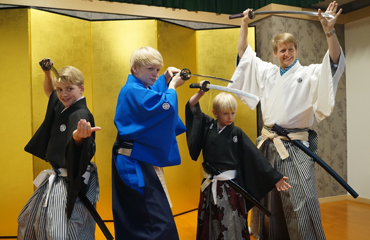 “Previously I had an image of samurai to a certain extent from movies, and also because my elder brother had lived here in Japan. That image has not changed very much, but it has been very interesting to actually wear a samurai costume and experience how to use a sword.”
“Previously I had an image of samurai to a certain extent from movies, and also because my elder brother had lived here in Japan. That image has not changed very much, but it has been very interesting to actually wear a samurai costume and experience how to use a sword.”
”Since we just came directly to Kyoto after arriving in Japan,” he went on, “I can’t make any comparisons with other places. But I like moving my body and experiencing culture. I think it would be a good opportunity to have a change of pace and get away from normal sightseeing.”
Demonstration of Sword Dances with Commentary
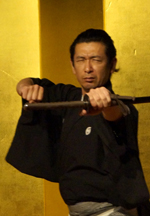 From 13:00 there was a demonstration of full-fledged sword dancing. The Huhta couple and Soffer brothers, who had been taking a break somewhere, returned to watch the performance. First of all, Ms. Magari introduced representative examples of Japanese traditional culture and explained that one of them, the sword dance, was a condensation of samurai culture.
From 13:00 there was a demonstration of full-fledged sword dancing. The Huhta couple and Soffer brothers, who had been taking a break somewhere, returned to watch the performance. First of all, Ms. Magari introduced representative examples of Japanese traditional culture and explained that one of them, the sword dance, was a condensation of samurai culture.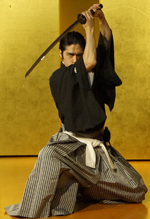 Then the masters performed traditional sword dances, with commentary during intervals on the actions and use of the folding fan in the dance, and finally a sword dance arranged in contemporary style. At the beginning of each dance the story is introduced in English, so even foreign visitors with little knowledge of history can understand the meaning of the sword dance being performed before their eyes.
Then the masters performed traditional sword dances, with commentary during intervals on the actions and use of the folding fan in the dance, and finally a sword dance arranged in contemporary style. At the beginning of each dance the story is introduced in English, so even foreign visitors with little knowledge of history can understand the meaning of the sword dance being performed before their eyes.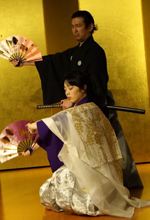 In the explanation of how to use a folding fan, the performer made a motion with a fan, and the members of the audience were asked what it meant. “That’s the wind. How about this?” A single fan is used to symbolize wind, rain, snow, falling cherry blossoms, and so on. Gradually the audience members began to understand this method of expression typical of Japan’s traditional performing arts. I was also surprised by the explanations of the meaning of seppuku (ritual suicide by disembowelment) and etiquette, which showed just how serious Ms. Magari is. She is tremendously hospitable toward visitors too, taking time at the end of the 60-minute demonstration to pose for photos with the other performers.
In the explanation of how to use a folding fan, the performer made a motion with a fan, and the members of the audience were asked what it meant. “That’s the wind. How about this?” A single fan is used to symbolize wind, rain, snow, falling cherry blossoms, and so on. Gradually the audience members began to understand this method of expression typical of Japan’s traditional performing arts. I was also surprised by the explanations of the meaning of seppuku (ritual suicide by disembowelment) and etiquette, which showed just how serious Ms. Magari is. She is tremendously hospitable toward visitors too, taking time at the end of the 60-minute demonstration to pose for photos with the other performers.
After the show I asked the audience members for their impressions. The Huhta couple said that they had been able to learn about the history and lifestyle of the samurai and that practicing how to use swords was much more enjoyable than just plain sightseeing. The Soffer brothers said that the history had been interesting and that while the samurai themselves had been just as they imagined, they were surprised how simple the kimono were.
Although the program is for foreigners, with everything from directions to commentary conducted in English, the content would be equally interesting for Japanese as well. Having won the support of foreign tourists on TripAdvisor, Ms. Magari’s next goal is to disseminate the attractions of sword dancing among young Japanese. One feels that target is not so very far away.
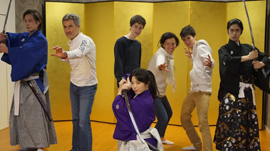
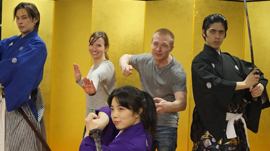
Samurai Kembu Co., Ltd. (Samurai Kembu Theater)
B1F Neo Art Bldg., Higashi-iru Sanjo-hanamikoji, 3-35-7 Higashiyama-ku, Kyoto 605-0005, Kyoto Prefecture
Tel.: 075-751-2033
URL:http://www.samurai-kembu.jp/
Nearest stations: 3 minutes on foot from Exit No. 1 of Sanjo-Keihan Station on the municipal subway Tozai Line
